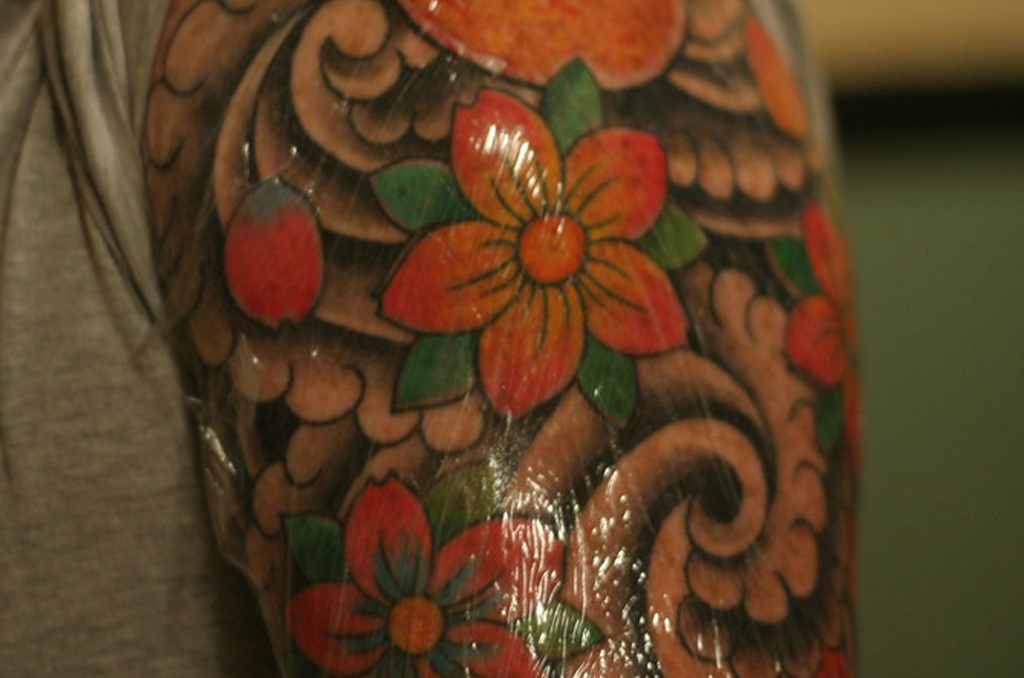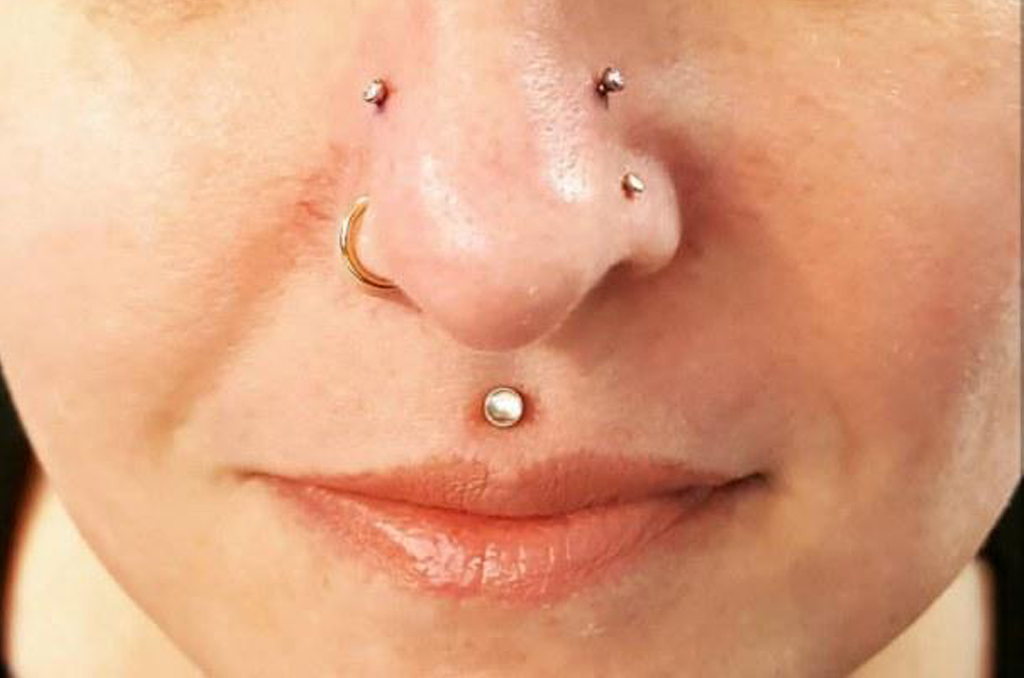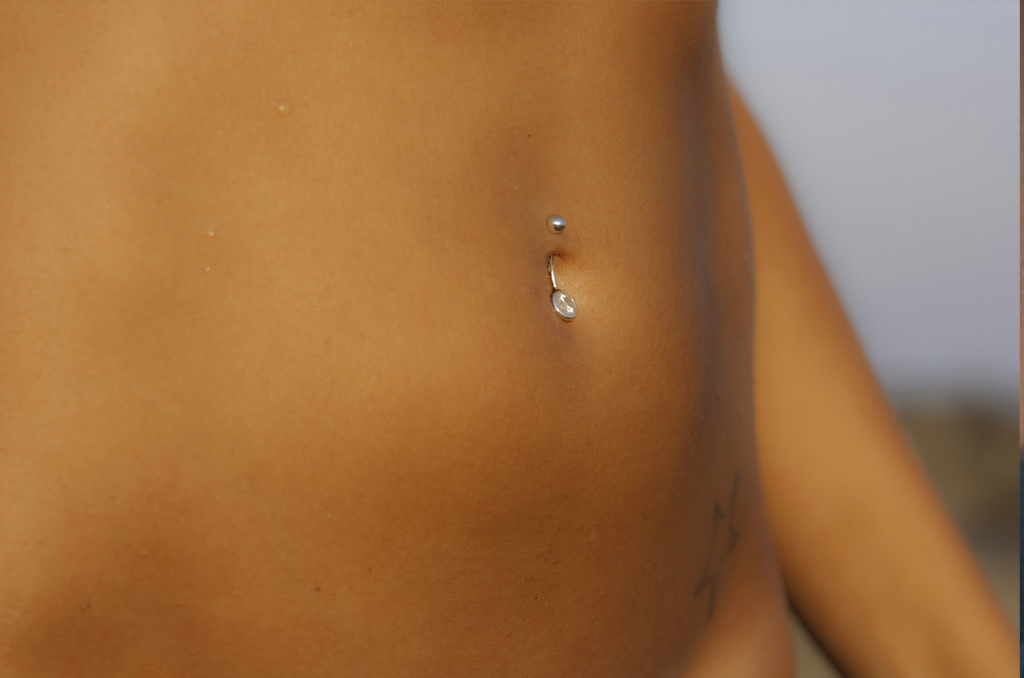Virginia Beach's Custom Tattoo & Piercing Studio
Whiskey River Tattoo is a custom and walk-in friendly tattoo studio located inside the Strawbridge Shopping Center. We also offer a wide variety of body jewelry and body piercing. Stop in today and chat us up about your ideas.
Tattoo
Click an artist to view some of their work
We carry a large stock of body jewelry from
Aftercare
No matter what, your body will heal. Touch ups are always available. This is why we guarantee our work. Remove the bandage after 3 hours. There is no need to re-bandage the tattoo. All wounds need to breathe if they are to heal properly.
Almost all artists will advise you to keep the tattoo moist. This can keep it from forming a scab. But what happens when that doesn't work? We notice a lot of people over-applying ointment and lotion too frequently or just too much of it. Keeping it too moist, to the point that it's nearly turning any repairing tissue to mush. Then, while they sleep the mush hardens, turning to a scab. Morning comes and on goes more goo that then absorbs into the scab turning it to mush again and later, dries out to form a thicker scab. More is not better. It won't make healing go any faster. This is not a scraped knee.
- Cleaning Solutions
- Inside the Mouth
- Exterior of Cheek/Lip
- What is Normal?
- What to Do
- Stay Healthy
- What to Avoid
- Jewelry
- Eating
- Read More
- H2Ocean mouth wash
- Antimicrobial or antibacterial alcohol-free mouth rinse
Soak in H2Ocean solution and/or wash with liquid antimicrobial or germicidal soap* as described below:
1 WASH your hands thoroughly prior to cleaning, or touching on or near your piercing for any reason.
2 SOAP no more than once or twice a day. While showering, lather up a pearl size drop of the soap to clean the jewelry and the piercing. Leave the cleanser on the piercing no more than thirty seconds, then rinse thoroughly to remove all traces of the soap from the piercing.
3 DRY with disposable paper products such as gauze or tissues, because cloth towels can harbor bacteria and catch on new piercings causing injury. Pat gently to avoid trauma.
- For the first three to five days: significant swelling, light bleeding, bruising, and/or tenderness.
- After that: Some swelling, light secretion of a whitish yellow fluid (not pus).
- A piercing may seem healed before healing is complete. This is because piercings heal from the outside in, and although it feels healed the tissue remains fragile on the inside. BE PATIENT, and keep cleaning throughout the entire healing period.
- Even healed piercings can shrink or close in minutes after having been there for years! This varies from person to person; if you like your piercing, leave the jewelry in place.
- Allow small pieces of ice to dissolve in the mouth.
- Take an over the counter, non-steroidal anti-inflammatory such as Ibuprofen or Naproxyn Sodium* according to package instructions.
- Sleep with your head elevated above your heart during the first few nights. To maintain good oral hygiene.
- Use a new soft-bristled toothbrush and keep it clean.
- Brush your teeth, and use your chosen rinse (saline or mouthwash) after every meal.
- During healing floss daily and gently brush your teeth, tongue and jewelry. Once healed, brush the jewelry more thoroughly to avoid plaque build up.
- The healthier your lifestyle, the easier it will be for your piercing to heal.
- Get enough sleep and eat a nutritious diet.
- DO NOT PLAY WITH THE JEWELRY. Long term effects of playing with and clicking the jewelry against the teeth can result in permanent damage to teeth and other oral structures.
- Avoid undue trauma; excessive talking or playing with the jewelry during healing can cause the formation of unsightly and uncomfortable scar tissue, migration, and other complications.
- Avoid any mouthwash containing alcohol. It can irritate the area and delay healing.
- Avoid oral sexual contact including French (wet) kissing or oral sex during healing (even with a long term partner).
- Avoid chewing on gum, tobacco, fingernails, pencils, sunglasses, etc.
- Avoid sharing plates, cups, and eating utensils.
- Avoid smoking! It increases risks and lengthens healing time.
- Avoid stress and all recreational drug use.
- Avoid any aspirin or alcohol, and large amounts of caffeine.
- Avoid submerging in bodies of water such as lakes, pools, etc.
- Once the swelling has subsided, it is vital to replace the original, longer jewelry with a shorter post.
- Consult your piercer for their downsize policy.
- Because this necessary jewelry change may occur during healing, it should be done by a qualified piercer.
- With clean hands or paper product, be sure to regularly check threaded ends on your jewelry for tightness ("Righty-tighty, lefty-loosey").
- Carry a clean spare ball in case of loss or breakage.
- Contact your piercer if your jewelry must be temporarily removed (such as for a medical procedure). There are non-metallic jewelry alternatives.
- Should you decide you no longer want the piercing, seek professional help in the removal of the jewelry and continue cleaning the piercing until the hole has closed. In most cases only a small indentation will remain.
- In the event that an infection is suspected, quality jewelry or an inert alternative should be left in place to allow for drainage of the infection. Should the jewelry be removed, the surface cells can close-up sealing the infection inside the piercing channel, resulting in an abscess. Until such time an infection is cleared up, leave quality jewelry in!
- Slowly eat small bites of food, placed directly onto the molars.
- Avoid eating spicy, salty, acidic, or hot temperature foods or beverages for a few days.
- Cold foods and beverage are soothing and help reduce swelling.
- For tongue piercing, try to keep your tongue level in your mouth as you chew and swallow.
- For labret (cheek and lip) piercings: Be cautious about opening your mouth too wide as this can result in the backing of the jewelry catching on the teeth.
- Each body is unique and healing times vary considerably. If you have any questions, please contact your piercer.
- Cleaning Solutions
- Cleaning Instructions
- What is Normal?
- What to Do
- What to Avoid
- Hints & Tips
- Read More
- We recommend H2Ocean as part of your daily cleaning
- Liquid anti-microbial or germicidal soap.*
1 WASH your hands thoroughly prior to cleaning, or touching on or near your piercing for any reason.
2 Use H2Ocean as directed.
3 SOAP no more than once or twice a day. While showering, lather up a pearl size drop of the soap to clean the jewelry and the piercing. Leave the cleanser on the piercing no more than thirty seconds, then rinse thoroughly to remove all traces of the soap from the piercing.
4 DRY with disposable paper products such as gauze or tissues, because cloth towels can harbor bacteria and catch on new piercings causing injury. Pat gently to avoid trauma.
- Initially: some bleeding, localized swelling, tenderness, or bruising.
- During healing: some discoloration, itching, secretion of a whitish-yellow fluid (not pus) that will form some crust on the jewelry. The tissue may tighten around the jewelry as it heals.
- Once healed: the jewelry may not move freely in the piercing; DO NOT force it. If you fail to include cleaning the piercing, as a part of your daily hygiene routine, normal but smelly bodily secretions may accumulate.
- A piercing may seem healed before healing is complete. This is because piercings heal from the outside in, and although it feels healed the tissue remains fragile on the inside. BE PATIENT, and keep cleaning throughout the entire healing period.
- Even healed piercings can shrink or close in minutes after having been there for years! This varies from person to person; if you like your piercing, leave the jewelry in place.
- Wash your hands prior to touching the piercing; leave it alone except when cleaning. It is not necessary to rotate the jewelry while healing except possibly during cleaning.
- Stay healthy. Get enough sleep and eat a nutritious diet. The healthier your lifestyle, the easier it will be for your piercing to heal. Exercise during healing is fine, just "listen" to your body.
- Make sure your bedding is kept clean and changed regularly. Wear clean, comfortable breathable clothing that protects your piercing while sleeping.
- Showering is safer than taking a bath, because bathtubs tend to harbor bacteria. If you would like to take a bath, clean the tub well before each use.
- Avoid undue trauma such as friction from clothing, excessive motion of the area, playing with the jewelry and vigorous cleaning. These activities can cause the formation of unsightly and uncomfortable scar tissue, migration, prolonged healing, and other complications.
- Avoid the use of alcohol, hydrogen peroxide, Betadine, Hibiclens or ointment.
- Avoid over cleaning. This can delay your healing and irritate your piercing.
- Avoid all oral contact, rough play, and contact with others' bodily fluids on or near your piercing during healing.
- Avoid stress and recreational drug use including excessive caffeine, nicotine, and alcohol.
- Avoid submerging the piercing in bodies of water such as lakes, pools, Jacuzzis, etc. Or protect your piercing using a special waterproof bandage* such as Tegaderm, which is available at drugstores.
- Avoid all beauty and personal care products on or around the piercing including cosmetics, lotions, and sprays, etc.
- Don't hang charms or any object from your jewelry until the piercing is fully healed.
- Unless there is a problem with the size, style, or material of the initial jewelry, leave it in place for the entire healing period. A qualified piercer should perform any necessary jewelry change that occurs during healing.
- Contact your piercer if your jewelry must be temporarily removed (such as for a medical procedure). There are non-metallic jewelry alternatives.
- Leave jewelry in at all times. Even old, well-healed piercings can shrink or close in minutes after having been there for years! If removed, re-insertion can be difficult or impossible.
- With clean hands or paper product, be sure to regularly check threaded ends on your jewelry for tightness. ("Righty-tighty, lefty-loosey" ).
- Carry a clean spare ball in case of loss or breakage. - Should you decide you no longer want the piercing, seek professional help in the removal of the jewelry and continue cleaning the piercing until the hole closes. In most cases only a small indentation will remain.
- In the event that an infection is suspected, quality jewelry or an inert alternative should be left in place to allow for drainage of the infection. Should the jewelry be removed, the surface cells can close-up sealing the infection inside the piercing channel, resulting in an abscess. Until such time an infection is cleared up, leave quality jewelry in! (In particular, the navel area)
- A hard, vented eye patch (sold at pharmacies) can be applied under tight clothing (such as nylon stockings) or secured using a length of ace bandage around the body (to avoid irritation from adhesive). This can protect the area from restrictive clothing, excess irritation, and impact during physical activities such as contact sports. (In particular, the ear/ear cartilage and facial region)
- Use the t-shirt trick: dress your pillow in a large, clean t-shirt and turn it nightly; one clean t-shirt provides four clean surfaces for sleeping.
- Maintain cleanliness of telephones, headphones, eyeglasses, helmets, hats and anything that contacts the pierced area.
- Use caution when styling your hair and advise your stylist of a new or healing piercing. (In particular, nipples)
- The support of a tight cotton shirt or sports bra may provide protection and feel comfortable, especially for sleeping.



































